
An Introduction to Web App Development: Technologies, Process, and Best Practices

What is a Web Application?
A web application is a simple computer program that uses a web browser to perform its tasks. To access this online service, all you need is a web browser and internet connectivity.
This application functions with the help of two main parts, namely: Server Side (back-end), and the Client Side (front-end). Storage, processing, and retrieval of data are done on the server side and client-side helps to display the retrieved data to the end user from the front end.
How does the web application work?
Web applications allow users to access them through browsers such as Google Chrome, Opera, Firefox, or Safari rather than downloading the application. A web application requires only three components: a web server, an application server, and a database.
A web server receives the requirements from the client, an application server processes the received request, and the data is saved in the database.
Let us go over the process:
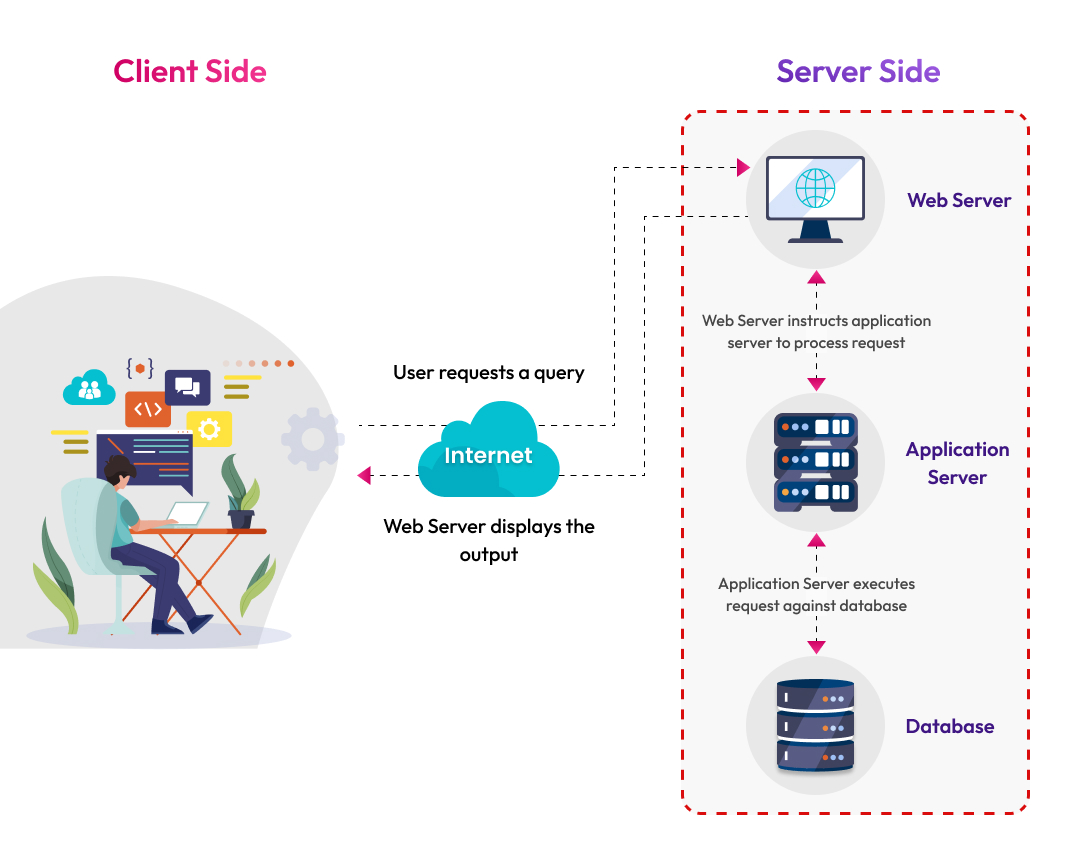
Step 1: User triggers a request on the internet via a web browser.
Step 2: The web server receives the request from the browser and instructs the web application server to execute the order.
Step 3: The web application server fulfills the command by generating results by processing the database
Step 4: The outcome is shared from the web application server to the web server.
Step 5: The web server displays the received information on the screen for the requested user via desktop or mobile device.
On the client side (front-end), the most commonly used are JavaScript, Cascading Style Scripts (CSS) and HTML5 for coding purposes. On the server side (back-end), Java, Ruby and PHP are some of the most popular languages.
What is Web Application Development?
Web application development entails creating an application using only a web browser, with only client-side and server-side programming required.
The creation process begins with the developer setting goals to solve a particular issue. The user interface is designed with the solution in mind. Information requests from the customer are received from the user interface, therefore, development is designed based on receiving and responding to the information.
The web development team has to incorporate the following into their design:
- The application is compatible with both Android and iOS.
- Build a user-friendly and interactive user interface
What are the different types of web applications?
A chart can be created on the different types of web application by the client
The listed below types of web application are categorized based on their functions, technology and tools.
| Static Web Application | As the name suggests, in a static web application, there is no relationship built between the user and the server. It directly displays the content to the user without processing any data on the server side. This simple type of web application provides access to basic animated elements or videos. On the flip side, they are difficult to update or modify. Their usage is not interactive and is meant to provide information to the users without receiving any input from them. HTML, CSS, and JavaScript were used to create this page. Noted examples are Siteleaf and Netlify. |
| Dynamic Web Application | Like the previous application, there is no interaction between the user and the server. However, the dynamic web application is versatile in terms of flexibility and interactiveness. It responds to the user’s needs in real time and gives them the freedom to post a comment, fill out a form, search for information, and so forth. On the flip side, they are more involved and complex in structure. They usually deploy a content management system to modify the content presented to end users. Technical tools: ASP.NET or PHP, were used to create this page. Noted examples are Facebook and Spotify. |
| E-commerce Web Application | An E-commerce web application is a commercial entity promoting the buying or selling of goods online. To be classified for e-commerce the web application needs to incorporate core features It distinguishes itself from dynamic web apps by incorporating core features such as an electronic payment gate, transaction integrations, a management panel for administrators (for managing orders, payments, updating, and deleting products), and users’ cabinets. Technical tools: ASP.NET or PHP were used to create this page. Noted examples are Amazon, eBay, Walmart, Swiggy. |
| CMS Web Application | A content management system (CMS) allows users to produce, maintain and alter the content on the website. The person making alterations to the site requires no prior web programming or mark-up languages. Their usage is seen in personal blogs, corporate blogs and media outlets. Noted examples are WordPress, Drupal, and Joomla. |
| Single-Page Application | Single-Page Applications dynamically rewrite the current web page with new data, removing the need to reload the page to display new content. It is built using both front-end and back-end technology and provides a great experience for the end users. On the flip side, it is a complex type of web application. A notable example is Gmail. |
| Progressive Web Apps | Progressive Web Apps are the most recent and widely used web application innovation. It incorporates the best of both worlds, the features of a website and mobile app and gives a superior user experience in comparison to other types of web applications. It provides the user with options for installation, offline functionality, push notifications, and app access without an internet connection. Well known examples are Starbucks and BMW. |
What is the difference between a web application and a website?
Web applications and websites are both the same as users need to access them via web browsers and the internet. At the top level, they look similar, though not identical, but when you scratch the surface, the lines are blurred.
Let us capture how they diverge from each other.
| Differences | Web applications | Website |
| Authentication | Mandatory. | No requirement for information websites. |
| Precompilation | Required before deploying. | Not required. |
| Integration | With other software it is a complex and cumbersome process. | It is hassle-free. |
| Functionalities | Complicated and numerous. | Simpler. |
| User-engagement | Dynamic and Interactive. | Static and provide a single-path informational feed. |
What is the difference between a web application and a mobile application?
Both web applications and mobile applications are very well-liked by users and have established reputations in the market. Yet, there is a reasonable amount of differences between them, which we would like to highlight.
| Differences | Web applications | Mob applications |
| Internet | Required to work on all devices | Not required for accessing devices |
| Expenditure | Development cost is lost but maintenance cost is expensive | On both counts, it stands out to be costlier. |
| Code | Common code base across all platforms and all users | It does not hold a common base code across all platforms |
| Installation | No installation required, can be viewed from any browser. | Only from the app. store |
| Security | Comparatively less. | Highly sophisticated. |
| Updation | It takes care of itself. | Frequent updates done through human intervention. |
Benefits of Web Application Development?
We have understood the key differences of Web Applications between Website & Mobile applications. Let us now have a look at some of the main advantages of developing web applications:
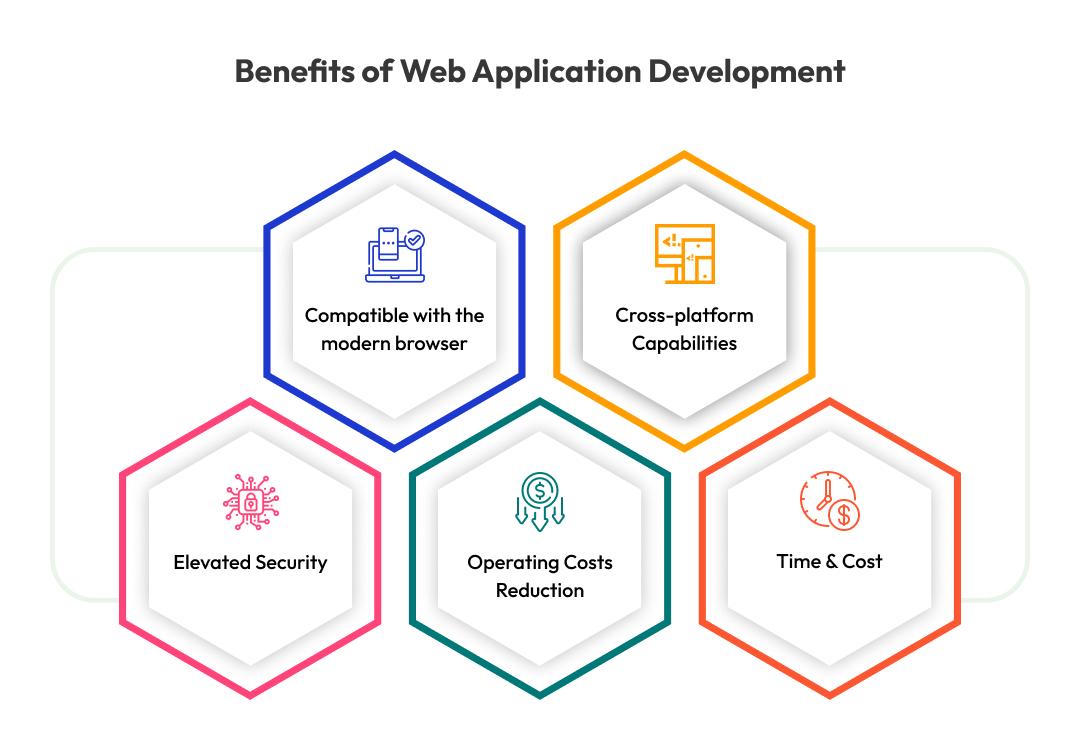
Compatible with the modern browser:
Software compatibility issues were never an impediment with modern-day browsers. Using an accessible URL, a web application runs smoothly on any device’s browser. All the browsers, including Google Chrome, Internet Explorer, Firefox, and Bing function harmoniously.
Cross-platform Capabilities
Web applications run efficiently on any operating system because of their programming. They transform rapidly to phones running on Android, Mac OS, and Windows due to their cross-platform capabilities.
Elevated Security:
Web applications are typically launched on dedicated servers and are maintained and monitored by a highly skilled technical team. Therefore, it favors no possibility of security breach and potential threat to its functioning.
Operating Costs Reduction:
Creating web applications helps struggling firms reduce their operating costs. It helps in minimizing all the associated costs related to the application, like frequent device updates, hardware purchases, and maintenance.
Time and Cost
Companies that want to put their product on the market usually prefer to do so through a web application, rather than developing native apps. It can be done at a fast pace and is less expensive. Further, there is no requirement for Google Play and Apple App Store for downloading web apps.
What are the key steps required for building a web application?
Many firms entertain the idea of web application development as they are aware of the benefits attached to it. Whether the application is developed with an in-house technical team or outsourced to a web application development firm like iSQUARE Business Solution, there are a few key steps to follow, keeping in mind the business goals of the firm.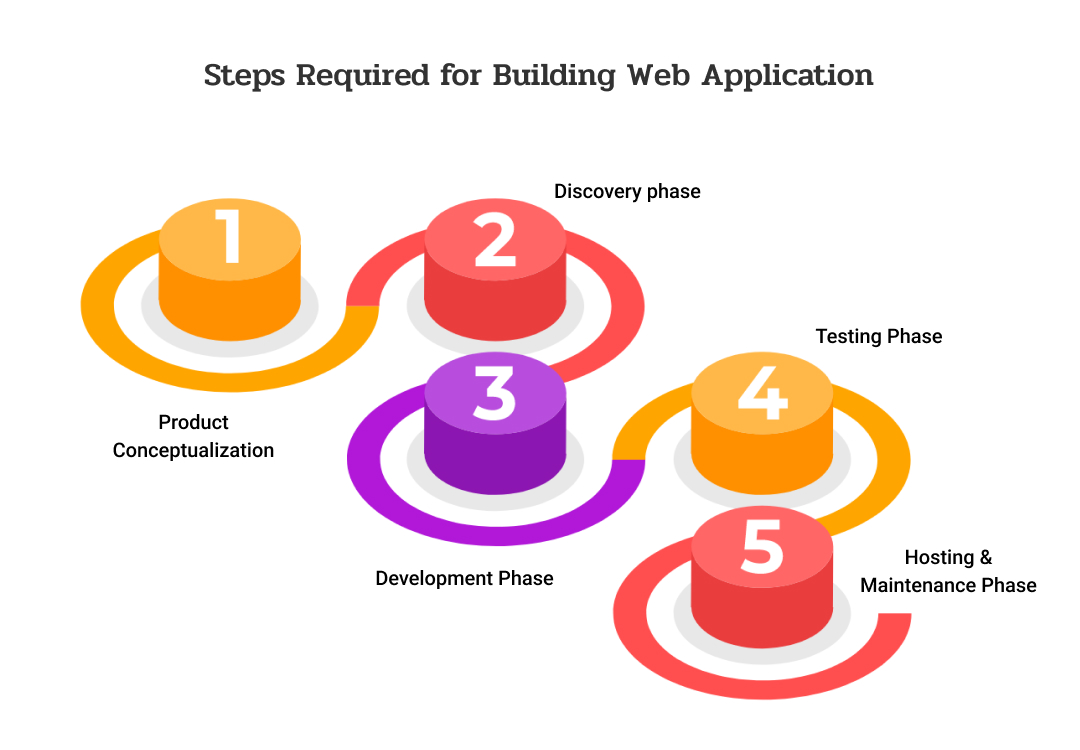
Product conceptualization:
The idea behind developing a web application is to find a solution for a problem we or people associated with us encounter frequently. Only once we have clarity about the problem, do the purpose and end-goals of the application become clearer.
The main questions you should be asking here are:
- What application do you want to build?
- What features and functions are required?
- Who are the audiences your product is trying to reach?
- What is the goal you want to achieve by building this product?
Discovery phase:
After the kick-off meeting with the entire unit (internal & external), the discovery phase is the time when your team can:
- Create wireframes or prototypes to communicate a solution to your problems. The feasibility of the objective is clarified here.
- Test the various web technologies and tools available.
- Define the minimum valuable product.
- Design the infrastructure and plan the period.
- Discover in-depth the needs, requirements and pain points of your target audiences.
Development phase:
The development phase takes care of these pointers:
- The database required for storage and the types of data required for the application developers decide beforehand.
- The front-end application is created by identifying the best frameworks.
- Interaction between users and servers takes place.
- Whether coding is done from scratch or using frameworks for front and back-end.
- Programming is done based on the application types such as the client-side, and single page.
Testing Phase:
Testing is an integral and inevitable part of application development. Since its inception, testing has been carried out at various stages of the product’s life cycle.
The quality assurance or testing team carries out a series of tests like compatibility, security, functionality, and performance to eliminate bugs and ensure a smooth product’s functioning. Testing helps to evaluate if the present set-up is sufficient or needs future upgrades.
Once testing is complete, launch the application at your firm. Train your employees on how to use it and let them give feedback. At iSQUARE, we vigorously test our developed products and train our clients’ employees on how to use them effectively.
Hosting and Maintenance Phase:
A decision needs to be made for the hosting server location. It can be shared, single, or cloud hosting, depending on your needs. However, whether you develop a website or web application, or mobile application, it is imperative to regularize the maintenance of your product.
- conduct regular QA tests,
- Include additional features based on product reviews,
- made routine upgrades and
- provide technical support to your product.
How can developing a Web application impact your business?
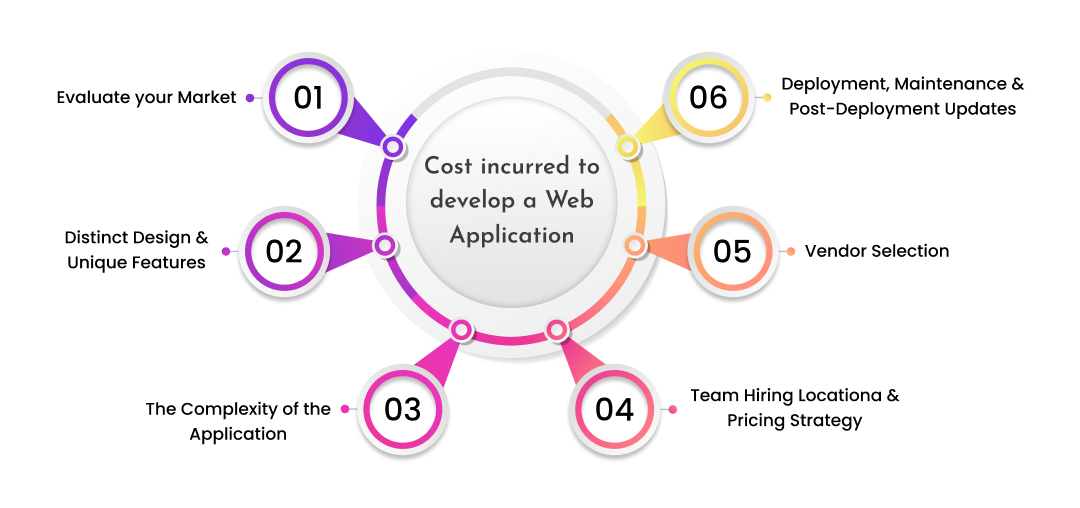
Many people are perplexed as to why web applications are created when mobile application development is so popular. However, web applications have their own set of benefits that help businesses.
Let us discuss a few points:
Informs your presence:
As a seller, if you are interested in selling your products within and beyond borders, then having a website is the first step. Once your customers know about your products, it becomes necessary to gain their trust. Approaching a web application development company and understanding your vision can help you launch. It helps to stand out amongst your competitors by clearly communicating the strength of your products. Having a web application is a guarantee of reassurance of your presence in the market. It is a ‘first point of engagement’ too.
Consolidates your brand:
Web applications help boost your brand’s image in the market. It acts as a messenger to showcase your plethora of products or services to prospective customers. With conviction, it portrays what the product represents, how it helps users, and what your brand means to the present and future generations of the customer base. A web application helps your brand consolidate its presence and expand its client base across various social media outlets.
Gains customer loyalty:
The requirement for a web application extends beyond displaying your products and services. It connects with your customers and helps them engage with your product. A web application helps develop customer loyalty by making a simple change to your application or major alterations based on their reviews.
Provides perpetual accessibility:
Customers have continuous access to web-based applications as long as they are connected to the internet. They can access your data at any time and from any device, whereas customers have problems accessing web app data at times due to maintenance or server issues.
User-friendly and resource-saving:
All devices include a browser, so users do not need to download a web application. The user gets the advantage of extra space on their devices and pays no cost for downloading the software. With internet connectivity, they can more easily navigate the web application than any other software.
What is the cost incurred to develop a web application?
Developing an application is no ordinary feat, it involves a contingent of people, technology, resources, and time to deliver the final product. No two web applications are identical, and each varies depending on the technology stack put into use. As a result, cost variation is unavoidable.
Let us narrate what factors influence the cost of web application development.
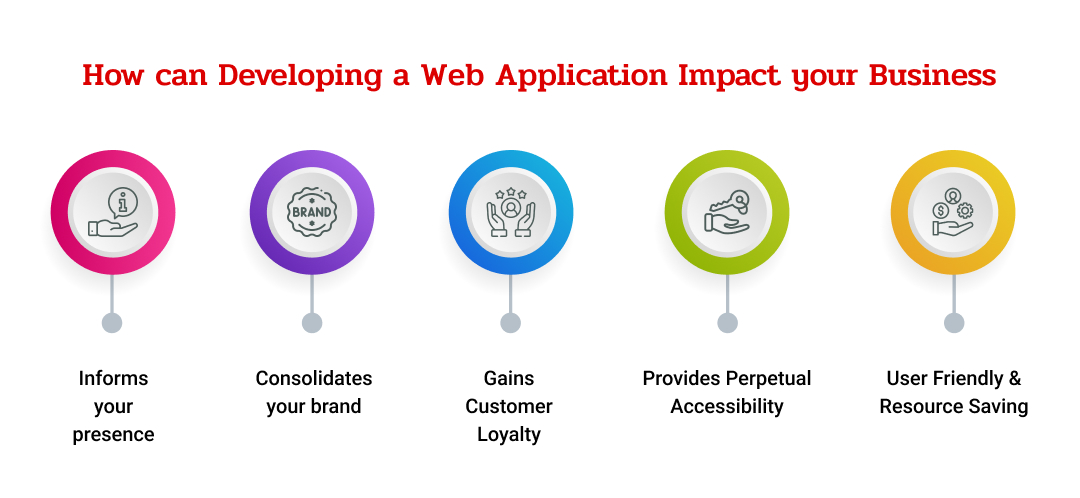
Evaluate your market:
A market study or research plays a crucial role in defining the project’s scope. The application’s basic structure and features are chosen as per market demand.
Distinct design and unique features:
The selection of design and features is subject to cost, time, and business requirements. The variances in the design and new features chosen to implement, apart from the regular features like the admin panel and user registration, impact the cost and time.
The complexity of the application:
The cost of developing a web app is directly proportional to the level of complexity added to the application.
The following are the main categories:
- Simple web apps – have basic and essential functionalities. They are developed rapidly and are cost friendly. Static web apps, MVPs, and apps built only for creating brand awareness are apt examples.
- Moderately complex web apps – have interactive pages. Their development process is both time-consuming and expensive. Dynamic web apps are built for the expansion of the customer base.
- Complex web app development projects – are challenging, time-consuming, and incur a massive expenditure in their development cycle. E-commerce web app development is complex and requires a knowledgeable technical team.
Team hiring location and pricing strategy:
Web development is a laborious task, and the cost required for hiring a technical team depends upon the geographical presence of the development team. Firms in developed countries need more skilled members who are expensive. On the contrary, technical professionals are abundantly available in South Asia, making hiring less expensive.
In the case of outsourcing, it can be either a fixed price till the project completion or an hourly basis per the scope.
Vendor selection:
The type of vendor for developing the web app depends entirely on our budget. Various development firms are in the market, bringing their experience on a platter to fit your price range, technology stack, and project scope.
Deployment, maintenance and post-deployment updates
Infrastructure expenses in web hosting and domain registration are also costly. After the application launches, additional maintenance expenditures, like fixing bugs and adding new features through updated versions, are incurred. With each update, more expenses are assured.
How can iSQUARE assist you in developing a web application?
Web application development is now crucial for firms as it helps them reach out to wider audiences in the digital world. If you have decided to outsource your web application development, never hesitate to contact us.
iSQUARE has been in the business for many years, offering assistance in all aspects of web applications. Contact Us to learn more.













